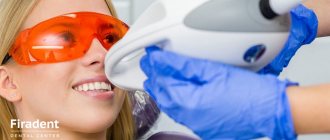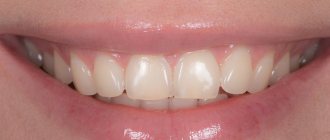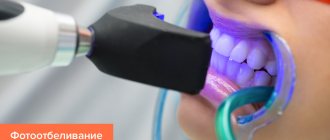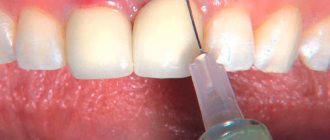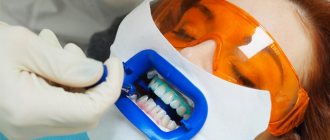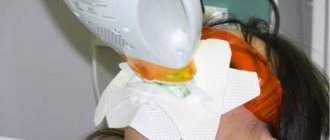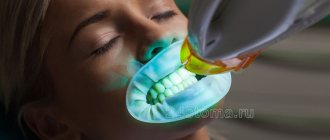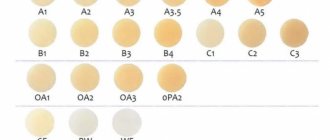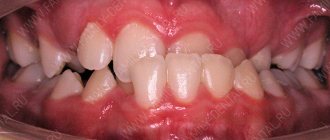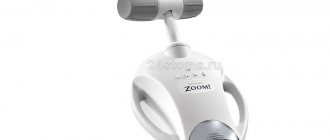Modern methods of obtaining a Hollywood smile make it possible to whiten teeth by 6 to 12 tones, and even remove old pigmented plaque. Procedures using ultrasound, laser, and the Zoom system are painless and safe, and the resulting effect lasts up to 5 years with proper oral care. However, when using even gentle techniques, the sensitivity of dental tissues increases, and the enamel loses part of its natural protection. After teeth whitening, it is very important to maintain your doctor's recommendations. They are aimed at reducing the risks of negative consequences and securing results.
Why is everything not as fast, effective and cheap as they promise in advertising!
Advertisements for any whitening systems talk about the safety, painlessness, speed, efficiency and affordability of the procedure, but do not pay due attention to proper preparation for teeth whitening.
Proper preparation takes time and may require additional financial investment.
The better the condition of your teeth, the less time and money it will take you to prepare for whitening.
Regardless of which whitening system you choose, the correct preparation is:
- will ensure the safety of whitening for teeth enamel
- will reduce the risk of pain during and after the procedure
- will give maximum whitening effect
Prepare properly for whitening and you will not be disappointed with the results.
Risks
When choosing the type of procedure, patients are primarily interested in which teeth whitening is the safest. What are the dangers of lightening the enamel:
- increased sensitivity, thinning of the enamel layer, uneven shade;
- premature abrasion of hard tissues;
- increased fragility and fragility of teeth;
- irritation, burns of the mucous membranes of the oral cavity due to an incorrectly selected method.
First, oral health, and then the beauty of teeth!
Agree that snow-white teeth do not go hand in hand with caries, inflamed gums and bad breath. A wide, “dazzling” smile will not be enhanced by the absence of some teeth and pronounced orthodontic problems.
In general, first a healthy (sanitized) oral cavity, and only then whitening - as the final touch to a flawless smile!
Despite the fact that teeth whitening is a cosmetic procedure and is done solely at will, it has contraindications.
Relative contraindications include :
- Caries, pulpitis, periodontitis
- Chips, microcracks of enamel and wedge-shaped defects (exposed necks of teeth)
- Increased tooth sensitivity
- Inflammatory processes on the oral mucosa and gums
Without knowing the true condition of the oral cavity and starting whitening, you risk experiencing acute pain and damaging your teeth and gums.
Absolute contraindications may differ for different whitening systems, so we will provide information on Philips ZOOM professional in-office whitening:
- Pregnancy and lactation
- Age up to 14 years
- Increased sensitivity to ultraviolet radiation and taking medications that cause tissue sensitivity to the effects of a light source (with this contraindication, chemical, lamp-free teeth whitening is possible)
It is recommended that you visit your dentist before any whitening procedure.
Factors on which the durability of the snow-white shade of enamel depends
- the chosen bleaching method and the number of tones that managed to change the shade of the enamel. The initial color of the teeth, as well as the clinical situation of the patient, also plays a great role.
- adherence to the “white” diet: it must be followed during the first 5-14 days after whitening procedures. But even after the enamel is restored and loses its excessive sensitivity, you should not rely on foods and drinks that can lead to permanent staining,
The “white diet” after the whitening procedure will preserve the results for a long time - A reasonable approach to teeth whitening: you should not resort to serious procedures more than once a year, since you still won’t achieve the best effect, but you can weaken the enamel, and then it will become even more susceptible to external influences and dyes. But it is allowed to use professional products that support results (for example, Zoom Day White), but not earlier than 3 months after the main whitening procedure,
- thorough oral care: your arsenal should include all the variety of products necessary for comprehensive home care (brush and paste, floss, irrigator, rinse suitable for the clinical case). You should not skip a single brushing of your teeth, and procedures should be carried out daily, morning and evening,
Using an irrigator will help maintain the achieved result. - removing food debris after eating: you should make it a rule to rinse your mouth with water or mouthwash so that plaque does not accumulate there,
- timeliness of professional oral hygiene: the procedure must be performed 1-2 times a year (if indicated and more often), otherwise a dense mineralized plaque will appear on the teeth, spoiling the aesthetics of the smile and leading to periodontal diseases,
- giving up bad habits: of course, we are talking about smoking, not only classic tobacco products, but also various vapes and electronic cigarettes, which are refilled with cartridges containing color dyes.
You should give up bad habits
After teeth whitening, you should be very careful when choosing personal hygiene products. For example, the same rinses. Many rinses contain dyes, as well as chlorhexidine, which can cause yellowing of the enamel. It is better if the products are recommended by a doctor.
Notice
: Undefined variable: post_id in
/home/c/ch75405/public_html/wp-content/themes/UltraSmile/single-item.php
on line
45 Notice
: Undefined variable: full in
/home/c/ch75405/public_html/wp-content /themes/UltraSmile/single-item.php
on line
46
Rate this article:
( 1 ratings, average: 5.00 out of 5)
whitening
- Zh. B. Sabdenova. Professional clinical teeth whitening // Medicine and ecology. – 2011.
- Lutskaya I.K. Current state of the problem of teeth whitening // International reviews: clinical practice and health. – 2022.
- Tuletaev A.A. Teeth whitening in 60 minutes // Bulletin of Surgery of Kazakhstan. – 2012.
Expert “It is important to understand that achieving the maximum possible effect that one or another professional (and non-professional) whitening method is capable of can only be achieved with careful preparation, which must include professional oral hygiene. During this procedure, soft and hard plaque is removed, the enamel is leveled, polished and strengthened.” Implant surgeon, periodontist Aida Vladimirovna Dzhutova
Consulting specialist
Varlamova Tatyana Vitalievna
Specialization: Dentist-therapist Experience: 6 years
What else you need to know before whitening
1) Whitening only changes the color of natural teeth . Fillings, inlays, veneers and crowns cannot be bleached. If such restorations are located in the smile area and after whitening they differ in color from “your” teeth, ask your dentist to replace them.
For the same reason , teeth treated before whitening are closed with temporary fillings in order to later replace them with permanent ones (with the selection of the appropriate color).
Replacement of restorations is carried out no earlier than 14 days after completion of whitening (this is the average time it takes for the formation of a new teeth color).
2) Depulped (dead) teeth that have darkened after nerve removal can be whitened only by intracoronal bleaching . This procedure must be performed before teeth whitening.
3) It is impossible to accurately predict and order a specific color . The result of whitening is individual for each person and depends on many factors.
For example: gray-brown teeth whiten worse than white and yellow teeth. “Fangs” bleach worse than “incisors.”
Teeth may whiten unevenly (the necks of the teeth remain darker), but after some time the color of the teeth evens out. If this does not happen, you can lighten the unsatisfactory color with additional bleaching procedures.
The only option to ensure the desired color that is the same for all teeth is to install ceramic veneers on the teeth “in the smile zone.”
Causes of darkening of enamel
The main factors that influence the shade of teeth:
- regular consumption of coffee, strong black tea, foods with dyes;
- bad habits, especially smoking;
- metabolic disorders in the body, systemic diseases;
- long-term use of certain groups of medications (in particular, drugs with tetracycline, etc.);
- reaction to a filling;
- natural age-related changes;
- depulpation (nerve removal).
The teeth are fine, but what color are they?
If the dentist finds no problems with your teeth and gums, you are almost ready for whitening.
All that remains is to do professional oral hygiene to determine the natural color of the teeth hidden under hard and soft plaque.
Knowing the original color, the doctor can predict what color will turn out after bleaching.
Whitening your teeth without first brushing means agreeing in advance to a worse result.
Details of this procedure can be found in the article Why You Need Professional Dental Hygiene
It is not recommended to carry out whitening immediately after professional oral hygiene.
What diet should you follow after whitening?
Before you whiten your teeth, you need to decide to change your diet for the next few weeks. In order for the resulting effect to be consolidated and preserved for a long time, they adhere to a white or transparent diet.
All foods that contain coloring pigments or that can cause darkening of the enamel are excluded from the diet:
- coffee, tea, red wine, juices, hot chocolate, cocoa, sweet sodas;
- beets, pumpkin, carrots, tomatoes, red cabbage;
- blueberries, blackberries, black currants, mulberries, blueberries, grapes, cranberries, pomegranates, raspberries, strawberries, cherries;
- black bread, buckwheat;
- spices with yellow pigment (turmeric, curry), paprika, cinnamon, nutmeg;
- confectionery products with artificial colors;
- liver, heart.
In general, the diet will remain rich, since there are many products and dishes included in the white diet. These include all light vegetables, meat, poultry, fish, milk and dairy products, potatoes, cereals, pasta, nuts, and oils. Among berries and fruits, white grapes, melon, pears, and bananas are neutral. Drinks you can drink are light juices, lightly brewed green tea, and mineral water.
Strengthen the enamel so it doesn't hurt!
During preparation for whitening, the dentist may recommend a course of remotherapy to strengthen the enamel and reduce its sensitivity.
The procedure is done in a clinic and continues independently at home for 14 days. Remotherapy can also be prescribed after teeth whitening.
We talk about remotherapy in the article What causes tooth sensitivity and will remotherapy help me?
Philips , which offers ZOOM whitening, for maximum safety and painlessness of the procedure, includes a special Relief gel in its whitening kits, which is applied to the teeth before and after the procedure.
Relief Gel strengthens enamel and reduces sensitivity during and after whitening.
See how Relief Gel protects your teeth.
Now that you are ready to whiten your teeth, let's figure out what whitening methods exist and what each of them is intended for.
Contraindications
Even if the patient has figured out what is the most effective and best method of teeth whitening, it is necessary to make sure that there are no restrictions. The procedure is contraindicated in:
- gestation and lactation period;
- the patient’s minor age, primary occlusion;
- individual intolerance to the components of whitening products;
- presence of orthodontic structures;
- oncological processes and undergoing a course of chemotherapy;
- damage to hard and soft tissues due to traumatic or other impacts;
- installed artificial prostheses;
- chronic pathologies of teeth and gums in the acute stage, acute dental diseases.
Each case is considered by the dentist individually. If you whiten your teeth if there are absolute restrictions, this can lead to serious complications.
What methods of whitening are there and why are there so many of them?
Each manufacturer has its own classification, but simply, all whitening systems can be divided into two types:
- Office (or “clinical”) whitening, which is performed by a dentist in a clinic.
- At-home whitening designed to whiten your teeth yourself.
In-office teeth whitening systems
Office systems differ from home systems in having a higher concentration of bleaching agent (hydrogen peroxide or carbamide), so they whiten teeth quickly and significantly better.
Only a dentist can perform such whitening.
Bleaching systems differ in the method of activation of the bleaching composition:
- photochemical - activation with ultraviolet, LED lamp or laser light
- chemical (lampless) – activation due to a chemical reaction
If you need to get a snow-white smile QUICKLY , then you should choose in-office teeth whitening systems.
Home teeth whitening systems
At-home systems are most often used to maintain the results of in-office whitening and are offered as:
- trays that hold the whitening gel
- whitening strips , pencils and toothpastes
If in-office whitening is not recommended for medical reasons, professional at-home teeth whitening can be used. A course of home whitening will give an effect close to that in the office, but still not the same.
Philips offers two professional home teeth whitening systems, ZOOM DayWhite and NiteWhite.
What to expect after home treatments
Many people understand that the best teeth whitening is the one that is performed under the strict supervision of a dentist. But sometimes you really want to try more budget-friendly solutions, so it’s important to know how many shades you can lighten your teeth using various home remedies, and how long the effect lasts after that. Let's talk.
The best whitening effect is provided by all sorts of strips, pencils and gels (used in conjunction with trays). They allow you to lighten the enamel by 3-5 tones, but only on condition that you have undergone thorough preparation for the procedures, and this or that product has been selected by the dentist taking into account the clinical situation. With careful oral care, positive results can be maintained for the next 6-12 months.
For whitening, the tray is filled with a special whitening composition
Whitening pastes and brushes allow you to achieve changes of 1-2 shades. However, numerous reviews say that the effect disappears immediately, as soon as you stop using these products. They cannot be used on an ongoing basis, otherwise they can make the enamel very thin and sensitive.
Those who prefer to limit themselves to traditional products, such as salt, soda, activated carbon and lemon, should not expect that their teeth will change much. Yes, if the color is initially not very dark and there is no mineralized plaque, the procedures are carried out systematically (1-2 times a week for a month) and all restrictions are observed during this period (quitting smoking, “white” diet), it is possible to whiten the enamel by 1 , maximum 1.5-2 shades. But it will not be possible to maintain the result for longer than 2-4 weeks even with very careful hygienic care of the oral cavity.
What color of teeth can you get and how to maintain the whitening results for a long time?
In-office ZOOM whitening brightens teeth by 6-8 shades on the VITA scale. The result lasts for 1-2 years , subject to proper dental care and maintenance courses of home whitening.
In the first days after teeth whitening, it is important to follow a “white diet” - refrain from eating coloring foods.
In-office ZOOM whitening can be repeated no earlier than after 1 year.
We hope that we have helped you understand the variety of teeth whitening methods and the nuances that allow you to achieve a magnificent snow-white smile.
If you decide to have your teeth whitened, we will be happy to advise, conduct an examination and recommend the best whitening system for you.
We invite you to a consultation at NORD DENTAL clinics
What is better to forget: bad habits
Conducting a session forces a person to get rid of some addictions. Smoking does not benefit the body at all, and bleached teeth will turn black very quickly if you do not stop the addiction to cigarettes. The ingredients of tobacco smoke accumulate in the micropores of the enamel, which is exposed due to the procedure and becomes too vulnerable.
The habit of modern people to consume large quantities of caffeine also has a detrimental effect on the whiteness of treated teeth. It is recommended to direct your efforts to combat such “addiction”, because the aggressive pigments of caffeine-containing drinks instantly penetrate into the dental surface and neutralize the effect that was obtained through the brightening manipulation.
So, the amazing whitening results can be maintained for a long period. It is necessary to adhere to simple hygiene rules, follow a diet and overcome bad habits. A snow-white smile makes the face attractive, so your efforts will be completely justified!
Teeth whitening prices
| Name of service | Price |
| Teeth whitening with Philips ZOOM 4 Prepare your teeth whitening properly and you won't be disappointed with the results. Find out how to prepare for teeth whitening, what whitening methods exist and how to do in-office whitening Philips ZOOM | 28000 ₽ |
| Teeth whitening with the Opalescence Xtra Boost system Unlike Philips ZOOM, the Opalescence Xtra Boost system whitens teeth without the use of a special lamp. Find out more about the effective teeth whitening with Opalescence Xtra Boost | 13000 ₽ |
| Intracoronal bleaching (one session) Depulped (dead) teeth that have darkened after nerve removal can only be whitened using intracoronal bleaching. | 2200 ₽ |
| Teeth whitening with a Doctor Smile diode laser. The Doctor Smile diode laser is a unique equipment with a wide range of capabilities. The laser is used in the treatment of root canals of teeth, to treat gum disease, during surgical operations and to activate a special gel during the whitening procedure. | 22000 ₽ |
| Whitening with Doctor Smile diode laser (1-2 teeth) | 3300 ₽ |
| Whitening with Doctor Smile diode laser (5 teeth) | 6600 ₽ |
| Home teeth whitening with Philips ZOOM Day White / Nite White system | 7700 ₽ |
| Home teeth whitening with Opalescence Patient Kit | 10600 ₽ |
| Manufacturing of individual trays for the upper and lower jaws for home whitening procedures | 5300 ₽ |
Zoom 4 – safe whitening mechanism
Initially, using a special scale, the doctor determines the existing color shade of the tooth enamel. The next step is protective treatment of the oral cavity. Finally, the initial application of the whitening composition to the front teeth (5 upper and 5 lower) occurs. After this, a hardware targeted effect occurs on the treated teeth using a lamp that produces ultraviolet radiation for 10-15 minutes. The protective treatment of the soft tissues of the mouth mentioned earlier is intended for this purpose. Special glasses are used to protect the patient's eyes. Then the gel is applied two more times and the procedure is repeated. Thus, the time spent at the dentist is no more than one hour.
One session will allow you to enjoy a charming smile for more than one year, and, compared to the previous generation, with Zoom 4 the effect lasts up to 25 percent longer (up to 7 years, subject to strict adherence to the doctor’s recommendations).
